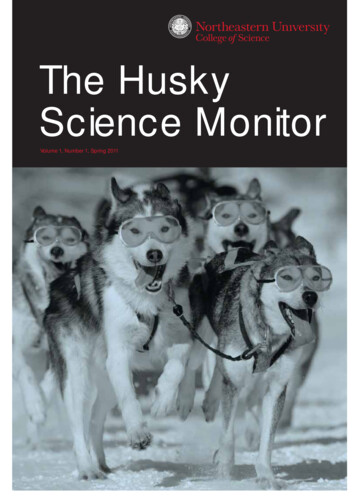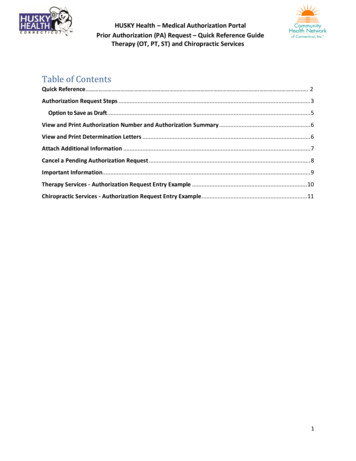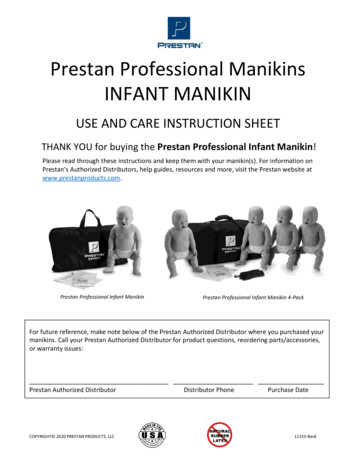
Transcription
The HuskyScience MonitorVolume 1, Number 1, Spring 2011/
contents12Message from the Dean3Fish May Change the Way WeLook at Spinal Cord Injuries456COS MajorsRevising a Classical Model ofSympatric SpeciationDid You Know Research and DiscoveryOnly Part of the MarineScience Center’s StoryAfter Peru, It’s Can-Do7From Co-Op to President:Ouellette’s Journey to the Top810Women in Science11Character Goes Under theMicroscope in DeSteno’s Book12PRISM Helping StudentsChoose A Career Pathin ScienceCalling Attention toNeglected DiseasesThe Nerd Alert13Making Sense of Jury DutyNew Faculty MembersIn Memoriam:Prof. Helen Lambert14Experience ScienceNortheastern 2015
Message from the DeanIhope you enjoy this inaugural newsletter from the College of Science at Northeastern. Weare excited about the opportunities that the creation of our College provides for the future,and we are grateful to our current and former students, parents, faculty and other supportersfor the legacy on which we will build.Let me tell you a little about myself andwhy I came to Northeastern last fall. I’m aScotsman by birth (yes I have a kilt but itdoesn’t fit any more), but I am a US citizenand have been in the US since 1978,after I earned my PhD in physics from theUniversity of Cambridge.I have worked at IBM Research, Bell Labs, the University of Illinois at Urbana-Champaignand, most recently, as Director of the Advanced Photon Source, the nation’s largest scientific user facility. In my research, I have studied the atomic structure inside nanomaterialsusing electron microscopes.I also love teaching, especially explaining science to non-scientists – check me out attinyurl.com/3wq47km.What attracted me to Northeastern is largely what attracts our bright young students –the unique experiential environment, outstanding faculty and staff, and prime location withgreat opportunities for partnering with other institutions.Amongst this list, I think experiential education is Northeastern’s real drawing card.Over my career, I have worked with many interns and summer students, but the timeand commitment that co-op offers allows for a much deeper working relationship betweenstudent and employer. And the ability of our students to mix work experience with the curriculum leads to a better education, wiser career choices, and a killer resume. Our studentsget to find out which career they have a passion for, and I firmly believe that you’ll be muchmore effective if you do what you love.Of course, I was greatly attracted by the opportunity to lead the new College of Science.The College provides a focus for the activities of our Departments of Chemistry, Physics,Mathematics, Biology, Earth/Environmental Science and Psychology, and our interdisciplinary programs.Thanks to the support of University leadership, the College has an outstanding opportunityto recruit a significant number of new faculty in the coming years, replacing retirements andexpanding in key areas. This year alone we hope to recruit 10 new faculty within the College.A high priority for me is strengthening our graduate program, which in turn will strengthenour undergraduates with new research opportunities. The College is engaged in strategicplanning (“Experience Northeastern 2015” http://tinyurl.com/3o7ec2s) to ensure that wemake choices in recruiting that bring us to the top level, relying on partnership with othercolleges and institutions to leverage our strengths.As we move forward, we will focus on integrating research, education and experientiallearning. The world is changing and I believe Northeastern has an exciting opportunity to bean academic leader by building from our unique strengths.There are also some important changes “under the hood” of the College that will facilitate our success. The University is moving to a distributed model for operations that givesthe deans more accountability and opportunity to invest resources. This is a smart move,fostering a more entrepreneurial environment that facilitates innovation. It also compensatesfor any “stovepiping” that comes from restructuring the College of Arts and Science since itencourages collaboration between deans.I am also happy to be staffing up my office with some excellent people – in particular I’dlike to single out Lori Lennon, Communications Coordinator, who produced this newsletter.Please let Lori know if you have any feedback on the newsletter (l.lennon@neu.edu).I hope you enjoy reading The Husky Science Monitor, and that you will engage with usas we work to secure our vision for the next decade at Northeastern. Feel free to contact meat COSDean@neu.edu.The ability of our students to mix work experiencewith the curriculum leads to a better education,wiser career choices, and a killer resume.J. Murray GibsonFounding Dean, The College of Science, Northeastern University1
A snail discovery ispromising to shake up the age-oldconcept of species formation.Northeastern University graduate student Meredith Doellman along withher advisors, Professors Geoff Trussell and Steve Vollmer and JohnGrahame – a collaborator from the University of Leeds in the UK – havefound that a marine periwinkle snail species – also known as Littorinasaxatilis – may have defied the simple textbook classifications of speciationby mixing both allopatric and sympatric speciation as it has evolved.Sympatric SpeciationIt is widely believed that new species mostoften arise when two populations becomegeographically isolated and diverge over time– a process known as allopatric speciation.Another, and far less common, form ofspeciation is sympatric speciation. In thiscase, natural selection promotes divergencewithin a population that eventually leadsto the creation of new species. Examplesof sympatric speciation are rare, but theygarner special attention from scientistsbecause of their novelty.Challenging the Traditional ModelUntil now, sympatric speciation was believedto only occur in species that inhabited thesame geographic location in or around thesame stretch of time.The paper, published in the Proceedingsof the Royal Society of London, Biological2Series, raises new questions about thisclassic model system of sympatric speciation by showing that L. saxatilis and its periwinkle relatives have a much more complexevolutionary history than previously thought.Researchers discovered that what wasonce thought to be one snail species mayactually be different snail species inhabitingrocky shorelines on both sides of the NorthAtlantic. “The species L. saxatilis definitelyneeds to be redefined – it is probably twospecies,” said Trussell. “This also meansthat within this group there is evidence formultiple, repeated examples of sympatricspeciation.”Evolution in ActionThis snail was found to have split into multiple morphological types (or species) in multiple locations in Europe, presumably due todifferences in the intensity of crab predation.Essentially, high crab predation has causedthe emergence of a thicker-shelled form ofthis species, which is less vulnerable to crabpredation, and this species has evolvedmultiple times across Europe.By analyzing DNA sequences from snailson both sides of the Atlantic, researcherswere able to show that periwinkle snail types,which give live birth to baby snails, apparently originated not once, but twice in thepast 640,000 years from their egg-layingrelatives L. arcana and L. compressa.Transatlantic SpeciesBoth periwinkle lineages now co-exist onboth sides of the Atlantic in a patchworkinfluenced by different colonization histories.The study even shows periwinkle snails thatbirth their young may be hybridizing withtheir egg-laying species.“This study will not change how scientists view sympatric speciation, but it willchange how they view speciation in thisclassic system,” Vollmer said.This American-European study emergedas part of the NSF Research CoordinationNetwork, “Coordinating Research on theNorth Atlantic” (CORONA) led by Dr. CliffCunnigham of Duke University.From left to right: Prof. Geoff Trussell,Director of the Marine Science Center,Meredith Doellman, and Prof. Steve Vollmer
l cord injuries are devastating, but fishmay be the key to finding a cure.Research shows adult fish that sustaina spinal cord injury have the miraculousability to both regenerate the spinal cord andrecover function – meaning they can perform tasks they were able to do prior tothe injury.For the past four years, NortheasternUniversity Biology Department Chair GüntherZupanc and his research associate,Ruxandra Sîrbulescu, have been studyingthis stunning recovery in fish.Their research was recently published inthe journal Brain Research Reviews.Zupanc’s team is examining how fish areable to regenerate the spinal cord, in hopesof ultimately finding a way to replicate thisprocess in humans. “To cure spinal cordinjury would be amazing and incredible forpeople who are suffering,” Zupanc said.According to the Christopher & DanaReeve Foundation, almost 1.3 million peoplelive with spinal cord injuries in the U.S. Theaverage cost for victims of spinal cord injuryranges from 230,000 to 780,000 in thefirst year alone. “In each case of spinal cordinjury, it’s devastating to the individual, families and society,” said Zupanc. “The ultimategoal is to cure spinal cord injury.”The first observation of a fish’s abilityto recover from spinal cord injury wasperformed as early as 1920 on goldfish.However, the behavioral observations werenot complemented with any examinationof structural changes.The research of Zupanc and Sîrbulescudives deep into the structural basis of thisamazing capability of fish, and observesthe step-by-step regeneration process ofthe spinal cord.According to Zupanc, after removalof part of the spinal cord, the injured fishsees a full recovery in as little as six toeight weeks.“We are learning how fish have thepotential to recover after these injuries,”said Zupanc. “Humans share with fish partof this potential. However, this ability hasbecome silent over evolutionary times. Thetrick will be to unravel the hidden potentialof humans, and fish may show us how todo that.”The discovery of spinal cord regeneration in fish is only the first step of a studythat could ultimately lead the way to makinglife-altering spinal cord injuries a thing ofthe past.3
Christa HoskinApplied Physics“I love being an Applied Physics major atNortheastern. I have experienced great teachers, great classes, and I love being a memberof the Society of Physics Students.”Dan PaulusPsychology“The PsychologyDepartment has beenlike a family to me,from the personableand helpful staff inthe office, to theknowledgeablefaculty membersand advisers whohave always hadtheir doors open.”Chelsea DeSantisLinguistics“The Linguistics Program at Northeasternis a small, intimate program with a passionateset of faculty and committed students. Thisdynamic makes it easy to get to know yourprofessors and classmates really well.”Janis LaiMathematics“The Departmentof Mathematics atNortheastern offersme flexibility andopportunities toexplore differentsides of me It givesme room to developmy personalityand find out wheremy future lies.”Steven CriscioneBiology“After I graduate inMay, I look forwardto pursuing a Ph.D.in cell biology atBrown University.I am thankful formy NortheasternUniversity experience,which has providedme with the researchopportunities andmentorship I neededto ensure my successin graduate school.”Caroline MalcolmEnvironmental Studies“Northeastern is lucky to have such a diverseand engaging department, and I feel that theknowledge and skills I have gained throughcoursework and hands-on field experiencesas an Environmental Studies major and Environmental Geology minor have prepared mefor many opportunities post-graduation.”Ryan SweeneyPhysics“Physics is a discipline that progressesevery day with newdiscoveries thatexpand our understanding of theUniverse. Physicistsat Northeastern,both faculty andstudents, are on thecutting edge of manyresearch domainsand are contributingto rewriting physicsas we know it.”Lauren MooreBiomedical Physics“Regardless of how difficult my course load canbe from time to time, I am very grateful to mybiomedical physics curriculum for challengingme to dig a little deeper, think from a differentperspective, and be a little better everyday.”Rhiannon ThomasChemistry“As a Chemistry major, I feel such a sense ofcommunity within the Department. Not only dowe have a close student group, but the professors are also really invested in their students.”Emily WiecekBehavioral Neuroscience“Behavioral neurosciencewas the perfectcomplement of biologyand psychologycoursework; I learnedhow to formulatequestions about thebrain and behaviorin my psychologyclasses, and my biologycoursework providedknowledge to helpanswer those questionswith current science.”Alyssa PandolfiEarth and EnvironmentalScience“The Environmental Science Department at Northeastern is more like a family than an academicdepartment. The professors, faculty, and studentsall know each other really well and are eager to helpeach other learn, discuss career plans, or just have afriendly conversation in the department lounge.”Jacquelyn SikoraBiochemistry“The mentorship Ihave received by theBiochemistry programhas given me valuableskills which allowedme to develop as ascientist and realizemy dreams. I havebeen afforded greatopportunities to meetand share my work withscientists in my field.”
dos”Physicists Rock!Did you know that physicists can getinvolved in the entertainment industry?Northeastern University Physics DepartmentChair Prof. Paul Champion recently organized a large international conference on aresearch topic that draws upon the use oflasers. Nobel Laureate Charles Townes, whohelped invent the laser, spoke at the conference. To celebrate the event, Championfound a company that goes on tour withmany of today’s hottest rock groups andasked them to put on a laser light show thescientists would remember. It turned outthat the company, Lightwave International,was founded and run by physicists! Theshow was amazing!Did You Know Scientists Havea Spooky SideYou Can’t Movethe Same Way Twicecentselpve ae.”Chemists Help KeepOur Country SafeDid you know that chemists play a rolein Homeland Security? Whenever youare screened at an airport, residues areanalyzed by a technique called mass spectrometry, which detects minute quantities ofnarcotics, explosives and other materials.Some of those techniques were developedright here at Northeastern University.Did you know at the InterdisciplinaryAffective Science Laboratory at NortheasternUniversity, psychological science aboutemotion coexists with a desire to giveback to the community? Each Halloween,Dr. Lisa Feldman Barrett and membersof the Interdisciplinary Affective ScienceLaboratory get in touch with their spookyside for a good cause. This past October,the lab used the science of emotion toterrify 425 boys and ghouls at their annualhaunted house for the Boston Food Bank.In addition to cultivating fear and fun,this event also raised 2,500 to feedhungry people in an around the Bostonarea – proving that fear is not alwaysa negative emotion.Did you know the human being is incapableof executing the exact same movementmore than once due to our inherent motorvariability and redundancy? For example,quantitative analysis of throwing a dartreveals that every movement is different,even in highly skilled performers. Prof.Dagmar Sternad and her research groupanalyzed sensorimotor performance andhave developed an analysis to decomposeobserved variability to extract noise in thesensorimotor system.5
Research and Discovery Only Partof the Marine Science Center’s StoryIn a way, the East Point of Nahant hascome full circle.Northeastern University’s Marine Science Center (MSC) sits atop East Point inNahant. From this spot, you can experiencebreathtaking views of the ocean and theBoston skyline.But the view is only part of what makesthis location special. “Some of the seminalmarine ecology research was done righthere on East Point, so this place has had areally long history of marine biology,” saidJoseph Ayers, a biology professor at Northeastern University.The Marine Science Center is locateda short distance from the former summercottage of Harvard professor Louis Agassiz,the founder of American marine biologyin the mid-19th century. Agassiz is hailedas a pioneer of marine science educationand promoted the formation of seasidelaboratories.Moreover, MSC Director Geoff Trussellnotes that, “modern experimental ecologygot its start in Nahant with the classic workof Bruce Menge and Jane Lubchenco.”Dr. Lubchenco is a member of theNational Academy and currently servesas the head of the National Oceanic andAtmospheric Administration.But that’s not where it all began.If you go back even further – the 1600s– the town of Nahant was a maritime community. The town’s small population was madeup of people who were devoted to fishing.At that time, settlers were given home sites,but only if they spent time fishing.In the early to mid-1800s, Boston’selite would spend their summers in a hotelthat stood on the MSC property. Some ofNahant’s popular residents included LouisAgassiz and other Harvard faculty.During WWII, the MSC site was usedby the military for the construction of defensive fortifications for Boston Harbor. Thefortifications consisted of a 5-inch cannonbunker, a larger 16-inch coastal defensecannon bunker, an associated plotting roomand triangulation towers that still standtoday. A Magnetic Loop station to detectsubmarines was housed in two smallerbunkers near the tip of East Point.In 1954, a Nike missile launcher site wasconstructed where an area known as LodgePark now stands.In 1967, the property came up as aGSA surplus. It was then that NortheasternUniversity acquired the land.When what was then known as theMarine Science Institute opened, Dr. Nathan“Doc” Riser became the Center’s first director. He held that position until his retirementin 1985.Even after his retirement, Riser spentmost of his time on the shores of East Pointconducting research. “He was a classicaltaxonomist,” said Ayers. “He did descriptivebiology. His classic posture was down onhis knees in the mud. He was just a reallywonderful man.”The MSC was his second home untilhis passing.After Peru, It’s Can-DoBy: Jason Kornwitz, Northeastern NewsShadowing doctors, dressing wounds andadministering antibiotics on co-op at a publichealth clinic in Cusco, Peru, inspired Northeastern University student Shane Smith toconsider a new challenge: medical school.“I would recommend international co-opto any student who’s not sure what field hewants to go into,” says Smith, a fourth-yearbiochemistry major. “Immersing myself in anew culture and language made me realizethat I can do anything.”Smith worked closely with doctors andlow-income patients at Belempampa HealthCenter, in Cusco. He dressed the woundsof a 19-year-old patient who contracteda flesh-eating disease from a sand fly; gaveinformational presentations on diseases,such as tuberculosis; and organized maternity rooms for obstetricians. One doctoreven taught him how to stitch a wound.The experiential learning opportunitysparked his desire to give back by helpingpatients get well.As Smith puts it, “I’m one of thosepeople who worry about how others are6being treated. Being able to help otherpeople at the clinic was just another stepin growing up.”He wants to make volunteering inCentral America a routine part of his life,and he’s not wasting any time.Smith plans to do part of his next co-opin Costa Rica and Guatemala, where he figures he’ll have a chance to work in a larger,more technologically advanced hospital –an experience more akin to his first co-opat Brigham and Women’s Hospital in Boston,where Smith analyzed blood samples fromheart attack survivors.He says that working and living inPeru prepared him for whatever a doctoror patient or local might ask of him.“I learned that I can adapt really wellto my surroundings,” says Smith, who notesthat his Spanish-speaking skills improvedgreatly during his co-op in Cusco. “Beingcompletely immersed in something is theonly way to learn.”
Today, the MSC continues to be aworld recognized center for marine scienceresearch and education.The bunkers used during wartime arenow filled with sea creatures and fossils thatare used to educate children of all ages inthe Nahant community and beyond.In addition to community outreach,the MSC also features lectures and unforgettable school visits.Just last month, the Center hostedthe 25th Annual Riser Lecture, given byDr. Emmett Duffy of the Virginia Instituteof Marine Science, which discussed thechallenges and opportunities of biologicaldiversity as the central organizing conceptin marine conservation and management.“This distinguished lecture, as well as thecontinued effort of the MSC community tobecome a top coastal research center, areall motivated by Doc Riser’s legacy,” saidTrussell. “We would make him proud.”The Center’s rich history and cuttingedge research has made it an important partof Northeastern’s framework, and its link tothe community is helping build relationshipswith some of the future’s brightest minds.Dr. Nathan “Doc” Riser,First director of theMarine Science CenterOld Nike MissileLauncher Site onEast Point, NahantSource for Nahant History: http://www.nahant.org/community/about.shtmlMarine Science Center,1967From Co-Op To President:Ouellette’s Journey to the TopBack in 1976, David Ouellette was lookingfor a co-op through Northeastern. In fact,the opportunities available through co-opare what attracted the chemistry major tothe University.Paving a Career PathOuellette found a co-op at Chemtan Company, Inc., located near his home in Exeter,NH. He took the job because it not onlyallowed him to explore the field of chemistry, itgave him a chance to figure out what careerpath he would like to take after graduation.Chemtan is an international leaderin developing, producing and marketingchemicals for the leather tanning industry.The company was started back in 1948by a group of five employee-partners whodecided to leave American Cyanamid. Theybelieved investment in products based onnew chemistries developed during and afterWorld War II would play a major role inleather making.Fueling a PassionOuellette enjoyed organic chemistry and hisco-op assignment gave him an opportunityto work in an area of chemistry he really feltpassionate about. “Chemtan providedme with a chance to understand how thingswere put together or used by our customers,”said Ouellette. “I received a comprehensivetraining approach. I felt I was really part ofthe company.”His Journey to the TopOuellette’s time at Chemtan would not endafter his co-op.In 1978, Ouellette graduated fromNortheastern and accepted a laboratorytechnician position at the company.After several years of developing skills inthe laboratory, Ouellette became Chemtan’sR&D director. In 2009, he was namedpresident – a title he shares with two otherNortheastern alumni, John Mitchell, COE ’68and Stephen O’Connor, COE ’60.Northeastern MemoriesLooking back on his days at Northeastern,Ouellette remembers Dr. Phillip LeQuesne(his favorite professor), the Blizzard of 1978,Punter’s Pub and spending hours in thechemistry lab. “I would leave my dorm roomat 8 a.m. and return at 5 p.m. every day.My roommates referred to me as the factoryworker.”Today, in addition to his leadershiprole at Chemtan,David Ouellette ismarried and hasthree children.7
Women in Science:Overcoming Struggles to Find Success8
Women have pushed to make strides in science, andwe are seeing examples of their achievements every day.But just like everything we do, success does not comewithout challenges – and being a woman in scienceis no exception.Where’s the Disconnect?According to University statistics, womenapplicants seeking graduate degrees in thesciences here at Northeastern are equal –if not exceeding – the number of men applying for the same degree, but over the years,there are two graduate programs that haveconsistently seen a larger number of maleapplicants – mathematics and physics.These stats highlight the challengesthat many women are up against while pursuing their passion for physics and science.Susan Ghiassian is a graduate studentstudying biological networks associatedwith rare diseases at Northeastern’s Centerfor Complex Network Research (CCNR).Before coming to study here at Northeastern, Ghiassian received a bachelor’s degreein physics in her native country of Iran.“It’s very competitive,” said Ghiassian.“I feel that I have to work twice as hard toprove myself to others.”Confidence is KeyBeing a physicist, Sabrina Rabello spenther years in academia surrounded by men.In fact, Rabello said many of the challengesshe faced during her years in school werenot the subjects she studied, but her surroundings. “I liked physics, I liked math,”she said. “But the social environment (atschool) was a little unbalanced I like thatthere are more women around me now.Sometimes I felt I had to hide the fact thatI was woman, but I don’t have the sameissues today that I had five years ago.”Rabello earned her undergraduatedegree in physics at the Federal Institute ofTechnology in Switzerland, got her PhD inapplied mathematics and theoretical physics at the Imperial College in London and isnow working on her postdoc at the CCNRstudying biological networks.“I think with time, you start gaining confidence in what you achieve, the work thatyou produce,” she said.Finding Supportin Role ModelsJust like any other area of life, finding peersand mentors to help guide you through yourcareer is key. This idea is applied very oftento women in science, simply because of thegender imbalance.Ghiassian said working in a maledominated area, such as physics, can bechallenging at times, and dealing with thecompetitive nature of the field can be overwhelming, but working with women, likeRabello, has helped create an environmentwhere she can grow and thrive.“It is always good to find other peers,role models, women who inspire you,”said Rabello.Leveling the Playing FieldMurray Gibson, Dean of the College ofScience at Northeastern University, recognizes this difficult challenge. Being a physicisthimself, he sees and understands thechallenges that women pursuing careersin science face.In an article published in Physics Today,Gibson addressed this very issue. He saidunderrepresented groups – not just women– face an invisible barrier that createsa hierarchy of sorts in disciplines suchas physics.As the founding Dean of the Collegeof Science, Gibson wants to increase thediversity of the scientific and engineeringworkforce by having the College take aleadership role in educating women andminorities.This begins by recruiting and retainingfaculty role models, Gibson explains.“Northeastern is fortunate to have a NationalScience Foundation ADVANCE grant thatfocuses on faculty recruiting.”So what is ADVANCE? Sara WadiaFascetti (College of Engineering), Directorof the program explains: “NortheasternADVANCE seeks to advance women ininterdisciplinary and international networksthrough recruitment, activities to retain andadvance faculty, and the engagement ofleadership in every aspect of ADVANCE.”The College of Science is determinedto have a better representation of womenin science. Just recently the College sponsored the International Women in Physicsconference held in South Africa.Adding AnotherLayer to ScienceThe pursuit of discovery and the abilityto solve complex problems are what inspireRabello and Ghiassian – not the competition. And that drive could very well be theingredient needed to reach the next levelof innovation.“If I am working on a problem, I like towork on it because I am inspired,” Rabellosaid. “I’m not thinking that ‘I have to do thisotherwise someone is going to publish this.’I just don’t see myself developing that kindof side.”It is safe to say there are challenges,but the truth is, Rabello and Ghiassian arepassionate about science, and the confidence that both women have learned toembrace has helped them realize that science is not just a man’s sport anymore.9
Calling Attention to Neglected DiseasesBy: Kara SheminNortheastern NewsChemistry professor Michael Pollastri andhis team of 12 post-doctoral, graduate andundergraduate students are combining theirscience skills and idealism to bring attention– and solutions – to diseases neglected byBig Pharma research.Neglected tropical diseases, such assleeping sickness and Chagas disease,affect the poorest parts of the world, whereunsafe water, poor sanitation and limitedaccess to basic health care are common.The diseases are typically transmitted byinsects and can result in debilitation or death.Pollastri says these diseases areneglected by the pharmaceutical industrybecause they would not be able to recoupor profit from the billions of dollars spent ondrug research and development.“It is not necessarily that the problemsof creating a drug for these neglected diseases are intrinsically more difficult, it’s thatthere hasn’t been a concerted effort fromindustry to do so,” said Pollastri, who specializes in medicinal chemistry and chemicaltechnology.Since receiving funding from the NationalInstitutes of Health in the spring of 2009,Pollastri has focused on research that willexpedite the drug-discovery process forneglected diseases.The effort supports Northeastern’scommitment to use-inspired research, witha focus on global challenges in health, security and sustainability.“There are very few people workingin this area, and I felt we could make a bigimpact,” he said.Pollastri and his research team collaborate with leading experts from across theglobe, including England, Spain, Switzerland and the United States, whose focusis on African trypanosomiasis, or sleepingsickness, and other neglected diseases.In his lab at
Grahame - a collaborator from the University of Leeds in the UK - have found that a marine periwinkle snail species - also known as Littorina saxatilis - may have defi ed the simple textbook classifi cations of speciation by mixing both allopatric and sympatric speciation as it has evolved. A snail discovery is











